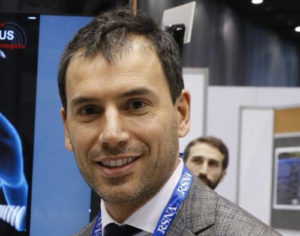
CT-guided pulsed radiofrequency is safe and effective in people with acute lower back pain that have not responded to conservative treatment, according to a study presented at the annual meeting of the Radiological Society of North America (RSNA; 25–30 November, Chicago, USA).
Conservative treatment options for herniated disks range from over-the-counter pain medications to injections of corticosteroids directly into the affected area of the spine. Those who do not respond may require surgery. In some cases, the entire disc must be removed and the vertebra fused together for stability.
CT-guided pulsed radiofrequency applies energy through an electrode to the portion of the nerve responsible for sending the pain signals.
“Pulsed radiofrequency creates a nerve modulation, significantly reducing inflammation and its associated symptoms,” said study senior author Alessandro Napoli, professor of interventional radiology at Sapienza University (Rome, Italy).
Napoli and colleagues studied the approach in patients with back pain from lumbar disc herniation that had not responded to prolonged conservative treatment. In 128 patients, the pulsed radiofrequency treatment was delivered directly under CT guidance to the root of the nerve. The treatment was applied for 10 minutes.
For comparison, a group of 120 patients received one to three sessions of CT-guided steroid injection on the same anatomical target with no pulsed radiofrequency.
The one-year outcomes demonstrated that CT-guided pulsed radiofrequency was superior to the injection-only strategy. Patients who received pulsed radiofrequency saw greater overall improvement in pain and disability scores during the first year. Relief of leg pain was faster in patients assigned to pulsed radiofrequency, and they also reported a faster rate of perceived recovery. The probability of perceived recovery after one year of follow-up was 95% in the pulsed radiofrequency group, compared with 61% in the injection only group.
“Given our study results, we offer pulsed radiofrequency to patients with herniated disk and sciatic nerve compression whose symptoms do not benefit from conservative therapy,” Napoli said.
The results of the study are superior to those typically reported for usual care strategies and injections and may help a substantial number of patients with sciatic disc compression to avoid surgery, Napoli added.
The use of pulsed radiofrequency also could improve outcomes for patients set to receive corticosteroid injections.
“We learned that when pulsed radiofrequency is followed by steroid injection, the result is longer lasting and more efficacious than injection only,” Napoli explained. “The effect of pulsed radiofrequency is fast and without adverse events.”
Today, therapy for spine disorders allows for definitive treatment of symptoms and conditions using different techniques and technologies.
“Of the different therapies available, pulsed radiofrequency is among the least invasive,” Napoli commented. “Treatment lasts 10 minutes, and one session was enough in a large number of treated patients.”












Is there any private doctors within the UK offering this
Treatment?
Thanks
Sei un GRANDISSIMO!!!!!!! Sono fiero di avere un nipote così in GAMBA pari alla sua MODESTIA. E vaiiiiiii ALE, Ti meriti tutto il successo che stai ottenendo e che continuerai ad ottenere in futuro.